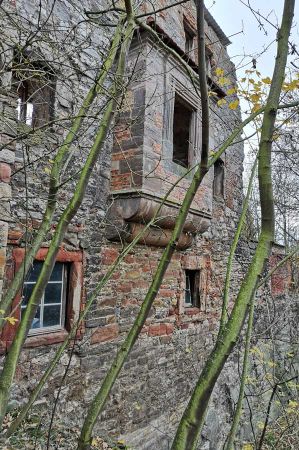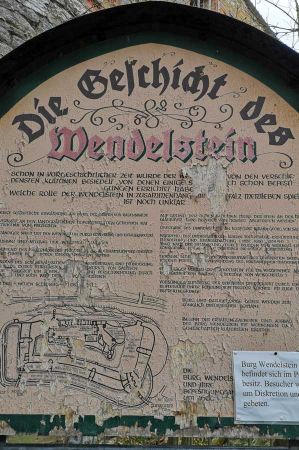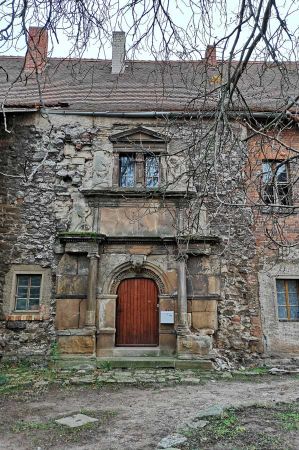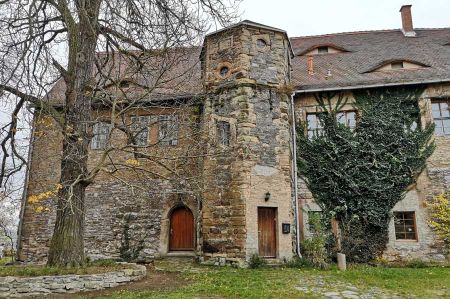Wendelstein Castle - stop on Unstrut cycle path
- Written by Portal Editor
Visible from afar and therefore attractive for visitors, the Wendelstein castle ruins are located between 30 and 50 meters above the Unstrut river on a gypsum rock that slopes steeply towards the shore.
The location on the gypsum rock makes the castle complex likely to be used as a border fortress between the Saxons and the Franks in the early Middle Ages; Scientists also discuss whether the Ottonian imperial palace Memleben could have been here. The small village of Wendelstein directly behind the castle ruins is part of the Kaiserpfalz municipality in the Burgenlandkreis in southern Saxony-Anhalt, which is named after the medieval castle ruins of the same name from the 14th century, which have already been partially renovated and are habitable again. The castle was at times expanded into the Wendelstein fortress.
User and owner in the course of history
 The castle is first documented in 1312 under the inherited possessions of the Counts of Rabenswalde, then again as Wendilsteyn in 1322.
The castle is first documented in 1312 under the inherited possessions of the Counts of Rabenswalde, then again as Wendilsteyn in 1322.
It initially belonged to the Counts of Weimar-Orlamünde, but they lost it in the Thuringian Count War (1342/1345) to the Wettin landgraves of Thuringia. Landgrave Friedrich II pledged the castle to his court judge Christian von Witzleben († 1374). Through this the expansion took place. The oldest part of the castle with defiant walls and towers is in front of the western building, here you can also see the remains of a Romanesque chapel. When Leipzig was divided in 1485, the castle fell to the Albertine Duchy of Saxony. After the Wittenberg surrender in 1547, the castle belonged to the Albertine Electorate of Saxony (Thuringian district).
In 1560 and 1590 further modifications were made to the residential palace. The north wing, which dates from the late Renaissance period, is just partially preserved, but still offers an impressive picture. The castle complex is surrounded by a stately moat that descends in several steps, which in turn is delimited by a wall with casemates.
Wendelstein Castle and its scattered property belonged to the Wendelstein line of the Lords of Witzleben until 1619. In 1623, Wendelstein and the associated rulership came into the direct possession of Elector Johann Georg I of Saxony as the Wendelstein office. During the Thirty Years' War the castle was devastated by the Pappenheimers in 1632 and by the Swedes in 1632 and 1640, later just simple half-timbered buildings were built. From 1657 to 1746 the Wendelstein office belonged to the Albertine secondary school principality of Saxony-Weißenfels, and from 1686 it was subordinate to the principality of Saxony-Querfurt in terms of economy and justice.
Horse breeding should bring economic growth
 In the 18th century, a well-known horse breeding from horses of Polish, Turkish and Tatar breeds arose. During the wars of freedom the stud was robbed of its horses on May 26th, 1813 by Lützower hunters under the command of Theodor Körner. The stud was not reoccupied; after Wendelstein was added to Prussia by the Congress of Vienna in 1815, the domain fell into disrepair. In 1981 renovation work was carried out on the castle ruins and apartments were set up in the remaining buildings in the west wing and the south wing facing the Unstrut.
In the 18th century, a well-known horse breeding from horses of Polish, Turkish and Tatar breeds arose. During the wars of freedom the stud was robbed of its horses on May 26th, 1813 by Lützower hunters under the command of Theodor Körner. The stud was not reoccupied; after Wendelstein was added to Prussia by the Congress of Vienna in 1815, the domain fell into disrepair. In 1981 renovation work was carried out on the castle ruins and apartments were set up in the remaining buildings in the west wing and the south wing facing the Unstrut.
In 2004 the castle was sold. The current owner was originally from Berlin, which we will turn to later.
In the late Gothic and Renaissance periods, Wendelstein Castle was expanded into Wendelstein Fortress. The massive fortress moat, remains of a rampart with ruins of several bastions penetrating through them, remains of casemates and the two fortress gates running underground through the ramparts have been preserved.
State of the fortress today
 Castle and fortifications are in a very ruinous condition. Foundation walls on a high rock and ruins below the rock have been preserved from the medieval Wendelstein Castle. The castle rock can still be climbed through a Renaissance stair tower. A roundabout is said to have been on the rock during the fortress period. In addition to the afore mentioned ruins of the castle chapel below the rock, a castle kitchen (chimney vent) and an apparently Gothic rondel (ruin) as well as the two underground fortress gates are particularly worth seeing. Parts of the casemates / cellars were closed to visitors. On the slope of the Unstrut river, there is the ruin of a water art (tower ruin), with which the fortress was once supplied with water from the Unstrut. The castle complexes, some of which are again used for residential purposes, are used privately. The castle courtyard is currently as freely accessible as large parts of the ruins.
Castle and fortifications are in a very ruinous condition. Foundation walls on a high rock and ruins below the rock have been preserved from the medieval Wendelstein Castle. The castle rock can still be climbed through a Renaissance stair tower. A roundabout is said to have been on the rock during the fortress period. In addition to the afore mentioned ruins of the castle chapel below the rock, a castle kitchen (chimney vent) and an apparently Gothic rondel (ruin) as well as the two underground fortress gates are particularly worth seeing. Parts of the casemates / cellars were closed to visitors. On the slope of the Unstrut river, there is the ruin of a water art (tower ruin), with which the fortress was once supplied with water from the Unstrut. The castle complexes, some of which are again used for residential purposes, are used privately. The castle courtyard is currently as freely accessible as large parts of the ruins.
The formerly defensive image is now softened by lush, flourishing green growth, ramparts and ditches are overgrown with grass and bordered by trees that block the view of the Wendelstein district; on the other hand, the view from the south is characterized by the bare, steep gypsum rock.
From the Wendelstein, the visitors have a beautiful view into the Unstrut valley and Thuringia.
Please read as well:
Unstrut Cycle Path - from Roßleben to Memleben
The bike path along the Unstrut river - Memleben monastery
-
 Impressive Castle Wendelstein at Unstrut Cycle Pathh
Impressive Castle Wendelstein at Unstrut Cycle Pathh
Impressive Castle Wendelstein at Unstrut Cycle Pathh
Impressive Castle Wendelstein at Unstrut Cycle Pathh
-
 Impressive Castle Wendelstein at Unstrut Cycle Path
Impressive Castle Wendelstein at Unstrut Cycle Path
Impressive Castle Wendelstein at Unstrut Cycle Path
Impressive Castle Wendelstein at Unstrut Cycle Path
-
 Impressive Castle Wendelstein at Unstrut Cycle Path
Impressive Castle Wendelstein at Unstrut Cycle Path
Impressive Castle Wendelstein at Unstrut Cycle Path
Impressive Castle Wendelstein at Unstrut Cycle Path
-
 Impressive Castle Wendelstein at Unstrut Cycle Path
Impressive Castle Wendelstein at Unstrut Cycle Path
Impressive Castle Wendelstein at Unstrut Cycle Path
Impressive Castle Wendelstein at Unstrut Cycle Path
-
 Impressive Castle Wendelstein at Unstrut Cycle Path
Impressive Castle Wendelstein at Unstrut Cycle Path
Impressive Castle Wendelstein at Unstrut Cycle Path
Impressive Castle Wendelstein at Unstrut Cycle Path
-
 Impressive Castle Wendelstein at Unstrut Cycle Path
Impressive Castle Wendelstein at Unstrut Cycle Path
Impressive Castle Wendelstein at Unstrut Cycle Path
Impressive Castle Wendelstein at Unstrut Cycle Path
-
 Impressive Castle Wendelstein at Unstrut Cycle Path
Impressive Castle Wendelstein at Unstrut Cycle Path
Impressive Castle Wendelstein at Unstrut Cycle Path
Impressive Castle Wendelstein at Unstrut Cycle Path
-
 Impressive Castle Wendelstein at Unstrut Cycle Path
Impressive Castle Wendelstein at Unstrut Cycle Path
Impressive Castle Wendelstein at Unstrut Cycle Path
Impressive Castle Wendelstein at Unstrut Cycle Path
-
 Impressive Castle Wendelstein at Unstrut Cycle Path
Impressive Castle Wendelstein at Unstrut Cycle Path
Impressive Castle Wendelstein at Unstrut Cycle Path
Impressive Castle Wendelstein at Unstrut Cycle Path
-
 Impressive Castle Wendelstein at Unstrut Cycle Path
Impressive Castle Wendelstein at Unstrut Cycle Path
Impressive Castle Wendelstein at Unstrut Cycle Path
Impressive Castle Wendelstein at Unstrut Cycle Path
-
 Impressive Castle Wendelstein at Unstrut Cycle Path
Impressive Castle Wendelstein at Unstrut Cycle Path
Impressive Castle Wendelstein at Unstrut Cycle Path
Impressive Castle Wendelstein at Unstrut Cycle Path
-
 Impressive Castle Wendelstein at Unstrut Cycle Path
Impressive Castle Wendelstein at Unstrut Cycle Path
Impressive Castle Wendelstein at Unstrut Cycle Path
Impressive Castle Wendelstein at Unstrut Cycle Path
https://www.alaturka.info/en/germany/saxony-anhalt/5220-wendelstein-castle-impressive-stop-on-unstrut-cycle-path?tmpl=component&print=1&layout=default#sigProIdb1d799f203
